Back in February, Toshiba announced the HK4 series, the latest addition to its high-performance, enterprise SSDs. The HK4 series comes in two models: a value endurance model and a read intensive model. Toshiba has doubled the maximum capacity of the drives, running all the way up to a maximum of 1.92TB (the HK3s topped out at 960GB). As with the previous model, the HK4 is a 2.5” form factor that supports SATA 6Gb/s interface. The HK4 also features vital enterprise functionality, including full power loss and end-to-end protection, as well as proprietary QSBC (Quadruple Swing-By Code) error-correction technology, the latter which helps to protect and secure data from corruption caused by NAND flash memory media wear.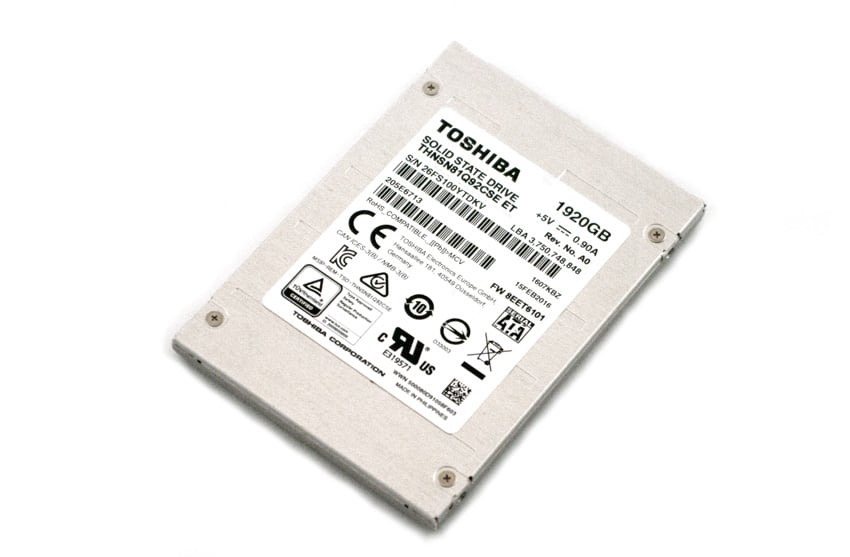
The HK4 uses Toshiba’s next-gen 15nm MLC NAND, Toshiba controllers, and provide what they refer to as class-leading application performance. The HK4 comes in two different models for two different use cases. The HK4R (which is the read intensive version supporting one drive write per day) is designed for applications such as web servers, files servers, media streaming, video-on-demand, search engines and warm data storage. The HK4R runs up to the higher 1.92TB capacity. The other version is a high-endurance, HK4E model. This model is designed with mixed workloads in mind and can provide up to three DWPD.
The HK4 comes in two models, five different capacities, and come with a 5-year warranty. For our review we will be looking at the read-intensive model with a capacity of 1.92TB.
HK4 series specifications:
- HK4R Series
- Form Factor: 2.5", 7.0 mm
- Model Name: THNSN8120P | THNSN8240P | THNSN8480P | THNSN8960P | THNSN81Q92
- Memory: 15 nm MLC NAND flash memory
- Capacity: 120GB | 240GB | 480GB | 960GB | 1.92TB
- Performance
- Sustained Sequential Read (64KiB): 500MiB/s
- Sustained Sequential Write (64KiB): 120MiB/s | 270MiB/s | 480MiB/s | 480MiB/s | 480MiB/s
- Sustained Random Read (4 KiB): 75K IOPS
- Sustained Random Write (4 KiB): 4K IOPS | 10K IOPS | 12K IOPS | 14K IOPS | 14K IOPS
- Interface: ACS-3, SATA revision 3.2
- Interface Speed: 6.0 Gbit/s, 3.0 Gbit/s, 1.5 Gbit/s
- Size (Length x Width x Height): 100.0mm x 69.85mm x 7.00mm
- DWPD: 1
Design and build
The exterior hasn’t changed much in design nor is there much reason to overhaul it. Enterprise SSDs are typically buried away in data centers and therefore need to perform versus having an aesthetic appeal. The outer casing is a simple aluminum body with a sticker on it that gives specifics such as model number, capacity, and certifications.
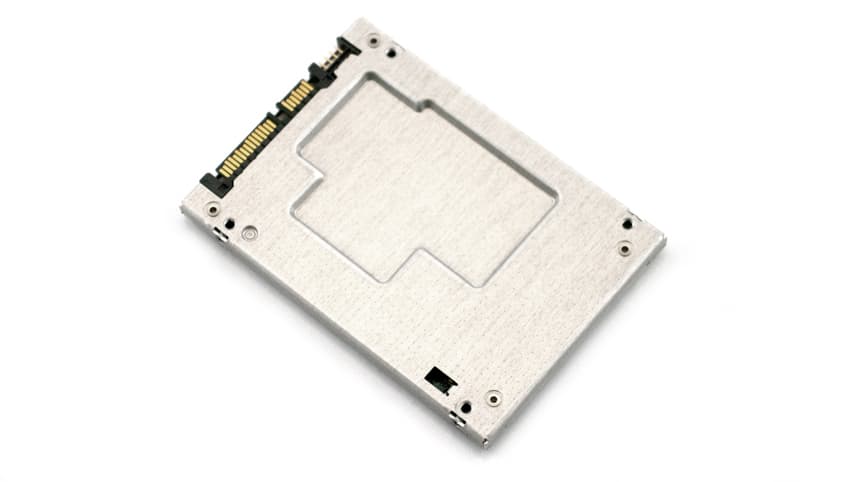
The sides and bottom of the device show the screw holes for mounting the drive.
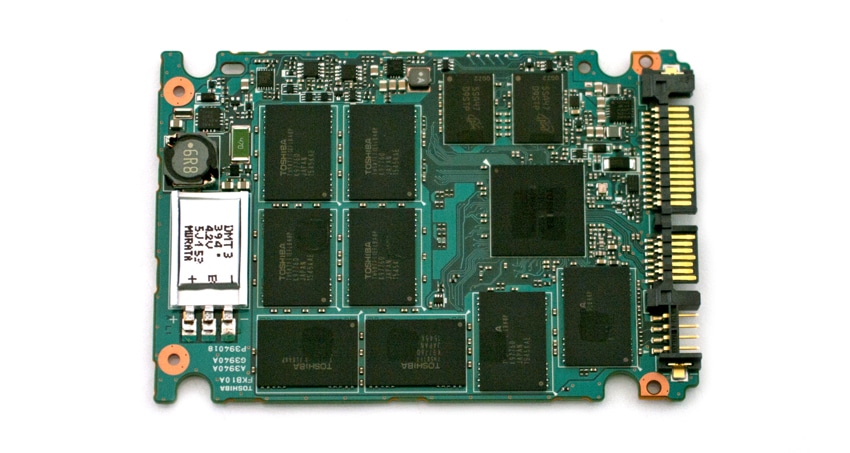
There are two sets of four screws in the drive. The first set holds the outer case on; the second set holds the PCB in place. Removing both sets of screws allows the PCB to pop out. On one side the Toshiba Controller and NAND packs are easily visible.
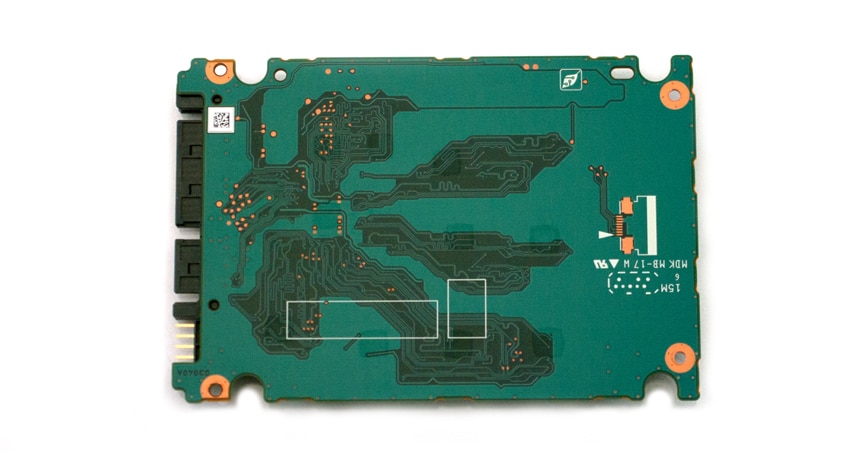
Much like the HK3, the NAND is only on one side of the PCB.
Testing Background and Comparables
The StorageReview Enterprise Test Lab provides a flexible architecture for conducting benchmarks of enterprise storage devices in an environment comparable to what administrators encounter in real deployments. The Enterprise Test Lab incorporates a variety of servers, networking, power conditioning, and other network infrastructure that allows our staff to establish real-world conditions to accurately gauge performance during our reviews.
We incorporate these details about the lab environment and protocols into reviews so that IT professionals and those responsible for storage acquisition can understand the conditions under which we have achieved the following results. None of our reviews are paid for or overseen by the manufacturer of equipment we are testing. Additional details about the StorageReview Enterprise Test Lab and an overview of its networking capabilities are available on those respective pages.
With this being one of the first 2TB SATA samples we've run through our testing process, we didn't have a group of comparables drives on hand for an apples-to-apples comparison. To help build a frame of reference, we pulled from our most recent SAS3 review group, where drives of similar capacity were run through our SQL Server and MySQL tests. These drives will show higher scores, which is expected, but also offer insight into how the Toshiba HK4 compares. Application workload comparables for this review:
- Seagate SAS3
- Toshiba PX04S SAS3
- HGST 1.6TB SAS3
Synthetic comparables for this review:
- Intel S3500 480GB
- Micron M500DC 480GB
- Samsung 845DC 480GB
- Toshiba HK3R2 960GB
- Toshiba HG6 512GB
- SanDisk CloudSpeed Eco 960GB
- Micron M510DC 480GB
- Samsung SM863 960GB (note: the SM863 is a mixed-use drive not a read-intensive drive)
- Samsung PM863 960GB
Application Workload Analysis
In order to understand the performance characteristics of enterprise storage devices, it is essential to model the infrastructure and the application workloads found in live production environments. Our first benchmarks for the Toshiba HK4 are therefore the MySQL OLTP performance via SysBench and Microsoft SQL Server OLTP performance with a simulated TCP-C workload. For our application workloads each drive will be running 2-4 identically configured VMs.
StorageReview’s Microsoft SQL Server OLTP testing protocol employs the current draft of the Transaction Processing Performance Council’s Benchmark C (TPC-C), an online transaction processing benchmark that simulates the activities found in complex application environments. The TPC-C benchmark comes closer than synthetic performance benchmarks to gauging the performance strengths and bottlenecks of storage infrastructure in database environments. Each instance of our SQL Server VM for this review uses a 333GB (1,500 scale) SQL Server database and measures the transactional performance and latency under a load of 15,000 virtual users.
When looking at SQL Server Output, we see the Toshiba HK4 trailing behind the faster SAS3 models, but that is expected being a SATA model. The HK4 gave us 6,245.67 TPS in aggregate and each VM was almost the same with 3,122.69 and 3,122.98 TPS. It should be noted that while it was the lowest performer in our benchmark, it was only 60 TPS slower than the top performer, the Seagate SAS with 6305.24 TPS.
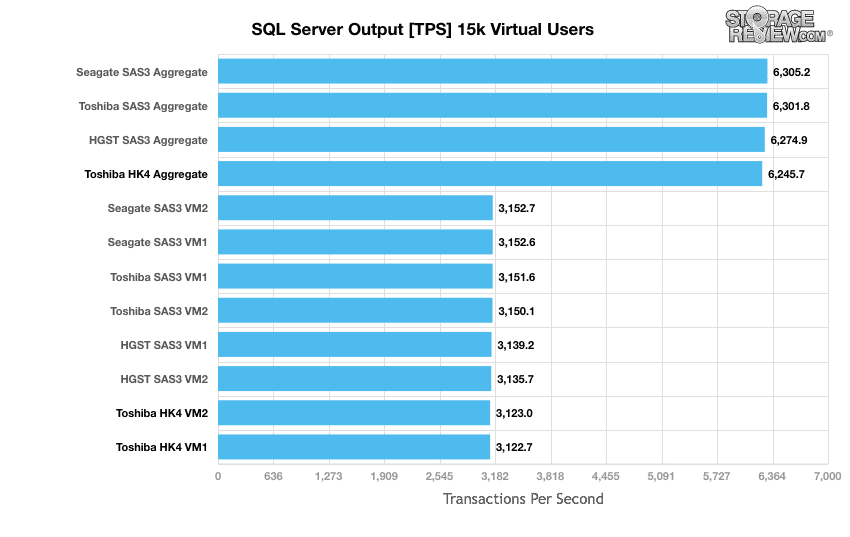
The HK4 had both individual VMs and had a latency of 61ms, which gave an average of 61ms as well.
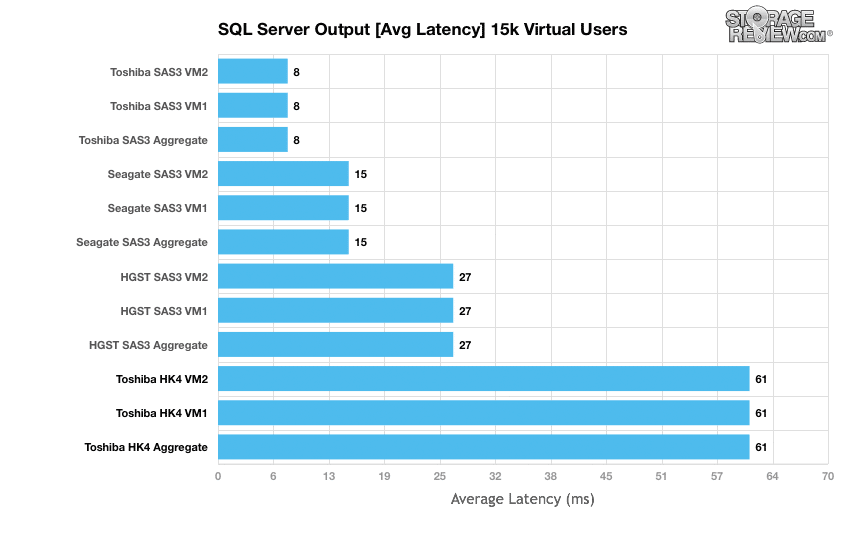
The next application benchmark consists of a Percona MySQL OLTP database measured via SysBench. This test measures average TPS (Transactions Per Second), average latency, as well as average 99th percentile latency. Percona and MariaDB are using the Fusion-io flash-aware application APIs in the most recent releases of their databases, although for the purposes of this comparison we test each device in their "legacy" block-storage modes.
In the average transactions per second benchmark, the SATA-based Toshiba HK4 trailed the SAS3 comparison drives but still performed the workload in a consistent manner. The individual VMs gave us TPS between 436 and 469 and the aggregate score was 1787.4 TPS.
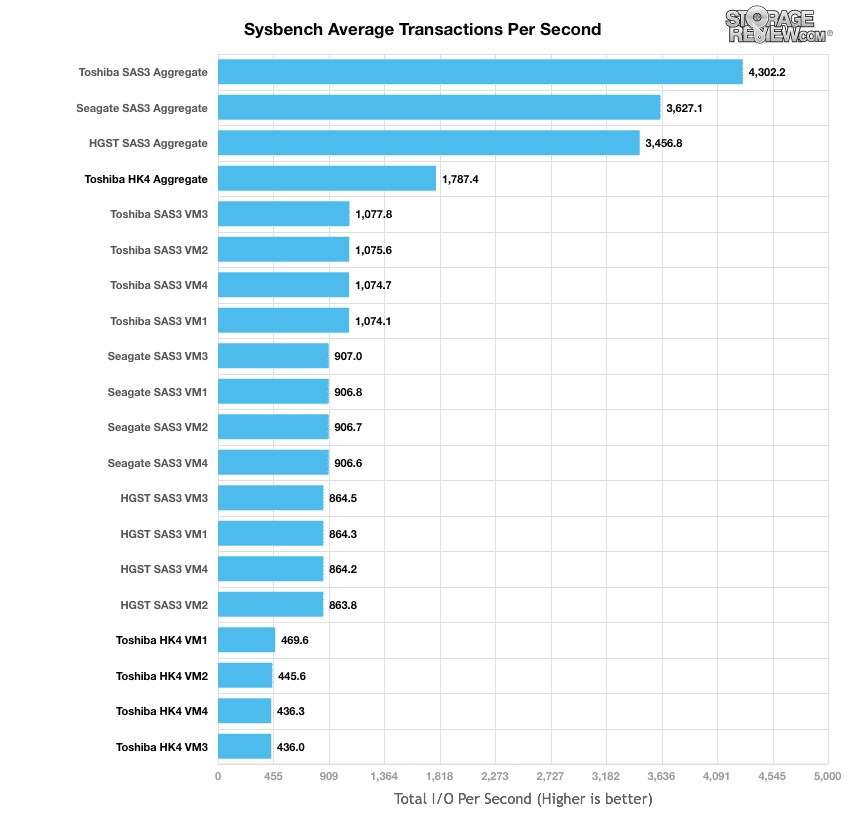
Looking at average Sysbench VM latency, we measured individual VMs between 68.15ms and 73.39ms, giving an average of 71.68ms.
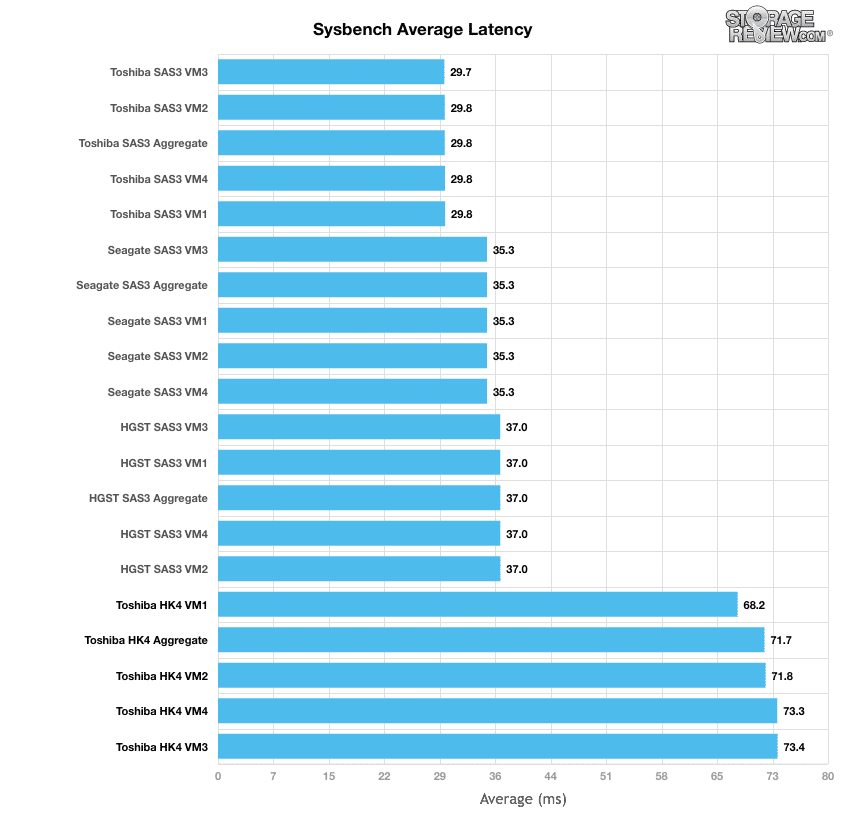
In terms of our worst-case MySQL latency scenario (99th percentile latency), the HK4 gave a latency between 135.15ms to 138.67ms, with an average of 137.41ms.
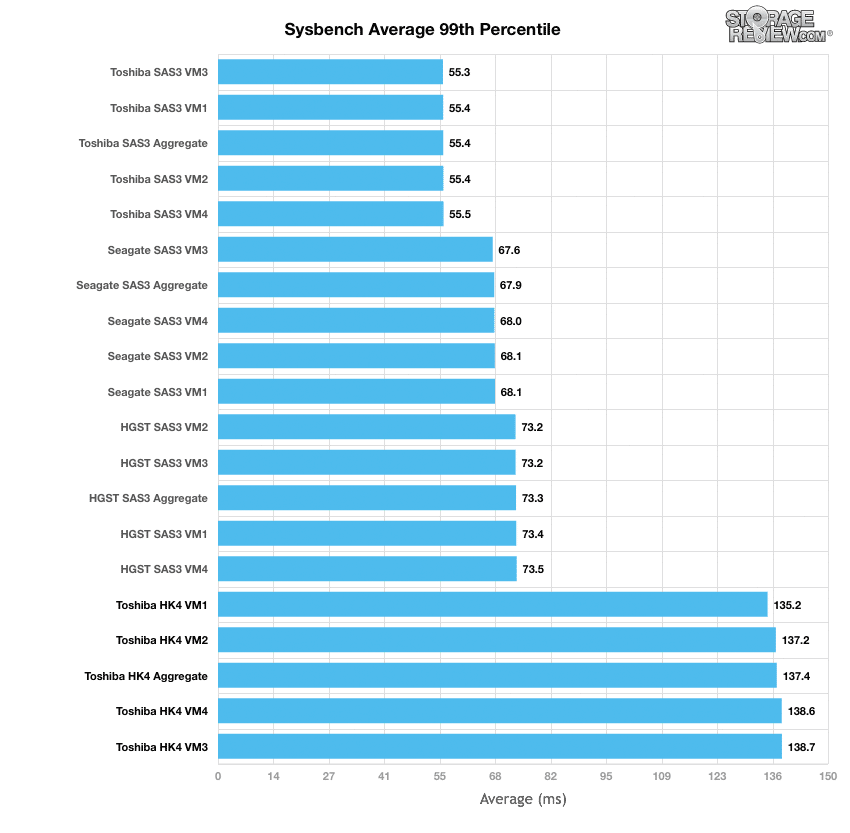
Enterprise Synthetic Workload Analysis
Flash performance varies as the drive becomes conditioned to its workload, meaning that flash storage must be preconditioned before each of the fio synthetic benchmarks in order to ensure that the benchmarks are accurate. Each of the comparable drives are secure-erased using the vendor's tools and preconditioned into steady-state with a heavy load of 16 threads and an outstanding queue of 16 per thread.
Preconditioning and Primary Steady-State Tests:
- Throughput (Read+Write IOPS Aggregate)
- Average Latency (Read+Write Latency Averaged Together)
- Max Latency (Peak Read or Write Latency)
- Latency Standard Deviation (Read+Write Standard Deviation Averaged Together)
Once preconditioning is complete, each device is then tested in intervals across multiple thread/queue depth profiles to show performance under light and heavy usage. Our synthetic workload analysis for the Toshiba HK4 uses two profiles which are widely used in manufacturer specifications and benchmarks. It is important to take into consideration that synthetic workloads will never 100% represent the activity seen in production workloads, and in some ways inaccurately portray a drive in scenarios that wouldn't occur in the real world.
- 4k
- 100% Read and 100% Write
- 8k
- 70% Read/30% Write
In our throughput 4k write preconditioning test, the HK4 starts off high and then falls down to fourth place before finishing second in a steady-state around 32,000 IOPS.
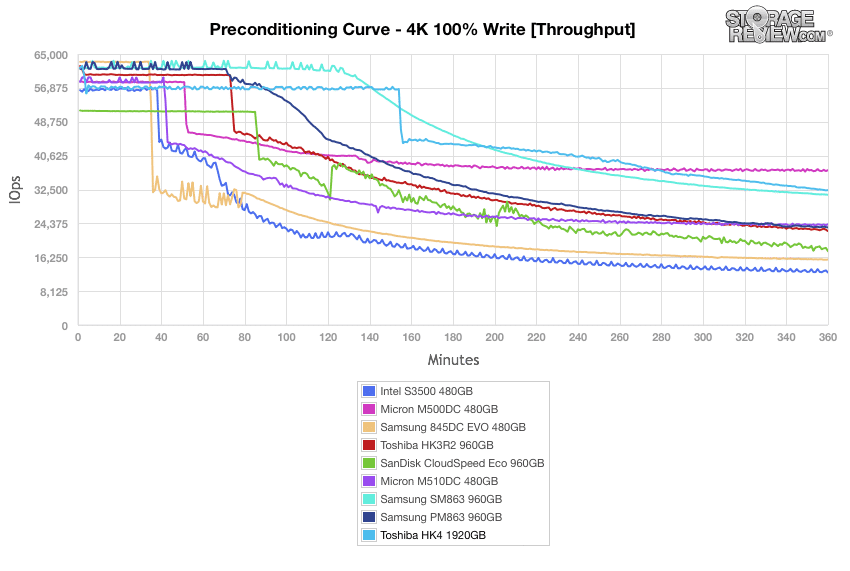
Looking at average latency preconditioning, we again see the HK4 with stronger performance throughout. There are times that the HK4 had the lowest latency before finishing second with a steady-state latency just under 8ms.
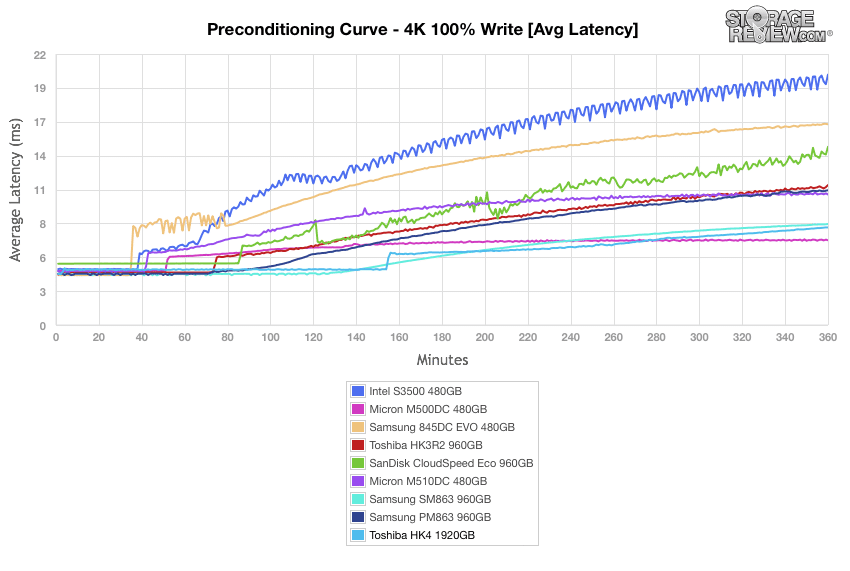
As with all max latency preconditioning tests that we run, we see several spikes throughout. The Toshiba HK4 was fairly consistent with only a handful of spikes 99.38ms being the highest. The drive finished in third place with a latency around 70ms.
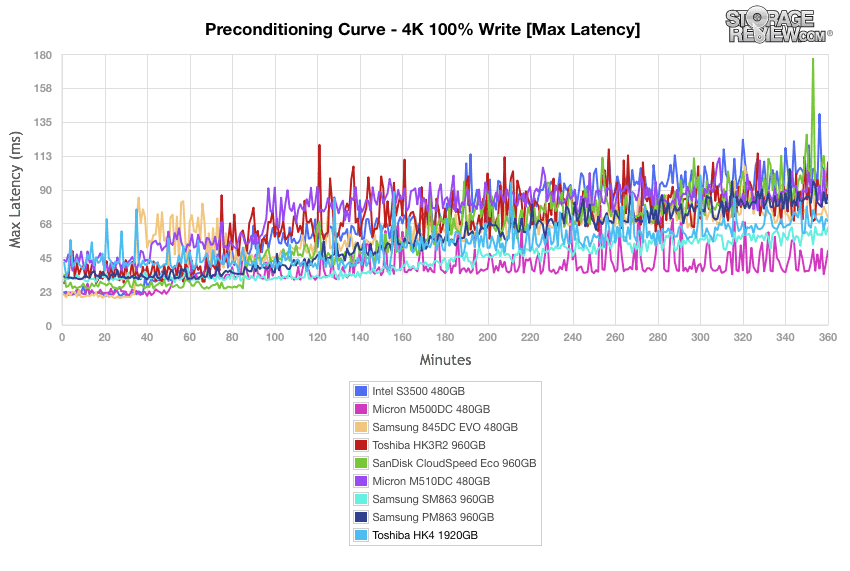
Standard deviation showed another consistent performance from the HK4. The HK4 ran neck and neck with the Micron 500DC before being edged out at the end to finish in a steady-state just under 6ms.
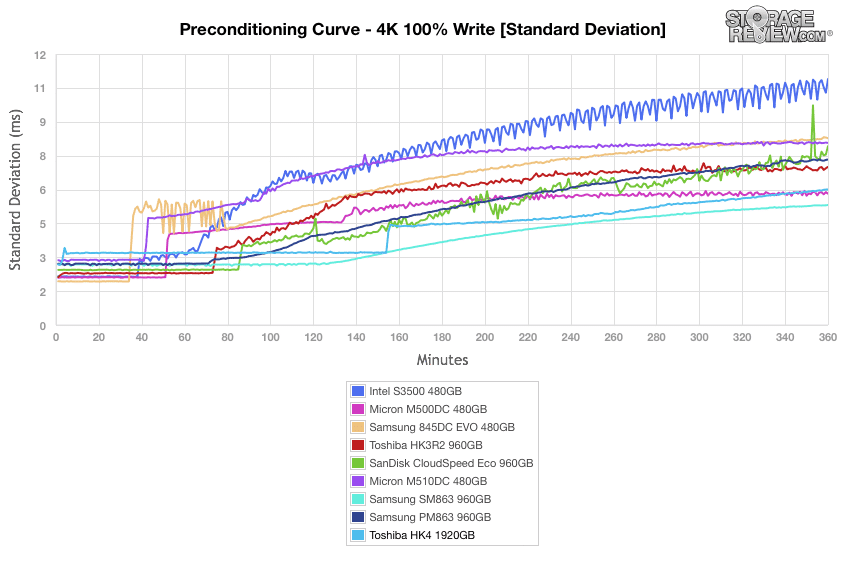
During the primary 4k synthetic benchmark, the HK4 came in as one of the stronger performers with a read throughput of 79,709 IOPS (placing it third overall) and a write throughput of 30,688 IOPS (placing it second overall).
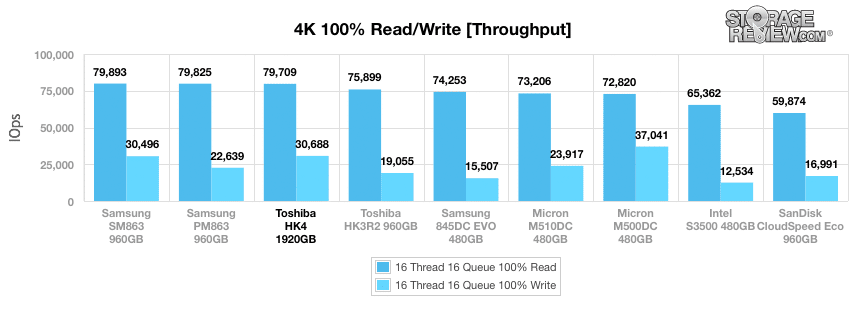
With average latency, the HK4 once again comes in near the top with a write latency of 8.34ms (the best of the group) and a read latency of 3.211ms (third overall but right on the heels of the two Samsungs, with the SM863 showing a latency of 3.203ms and the PM863 a latency of 3.206ms).
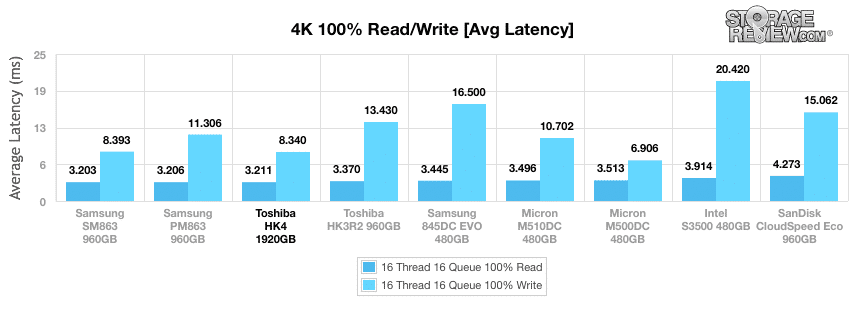
Looking at max latency, we see the HK4 slip behind most of the other drives in read latency with a speed of 27.973ms, the second highest. The HK4 did have much better write speeds with a latency of 96.288ms, placing third.
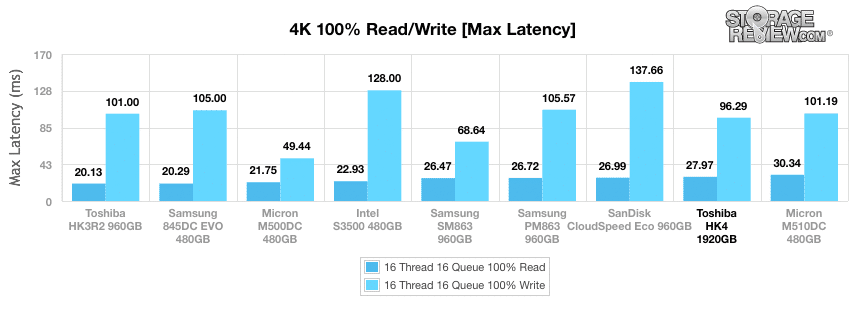
Standard deviation shows a read latency about in the middle for the HK4 at 2.048ms, and a write latency in third once more with 6.285ms.
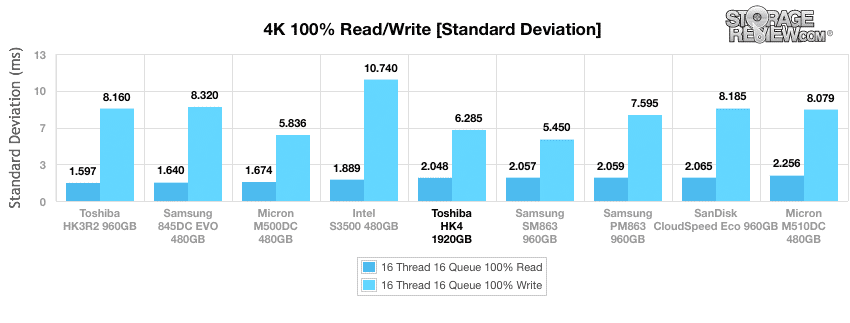
Our next workload uses 8k transfers with a ratio of 70% read operations and 30% write operations. Once again we start off with the preconditioning results before switching to the main tests. Here the HK4 repeated its placement of the 4k preconditioning with a strong start that leads to a high finish. The HK4 comes to a steady state around 39,000 IOPS.
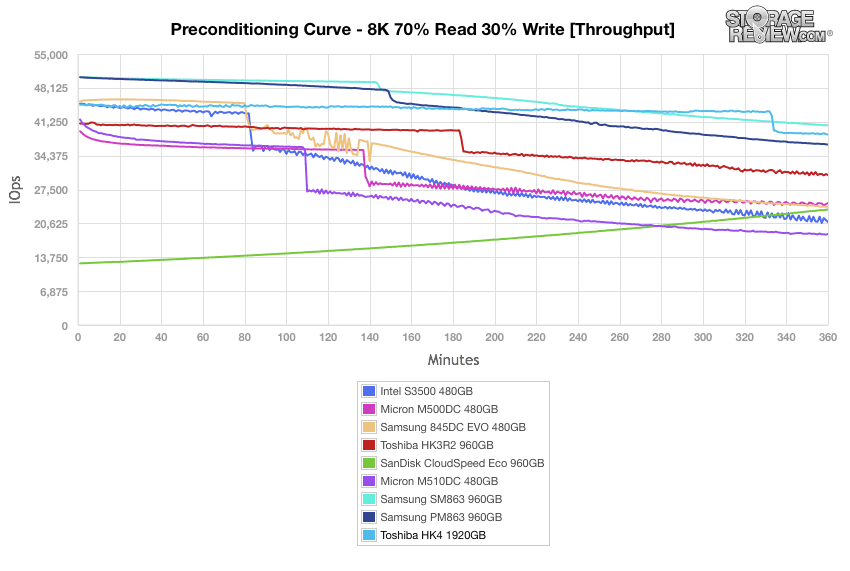
Looking at average latency, once again the HK4 starts off strong and finishes in the top of the pack, second place, with a steady state around 6.5ms.
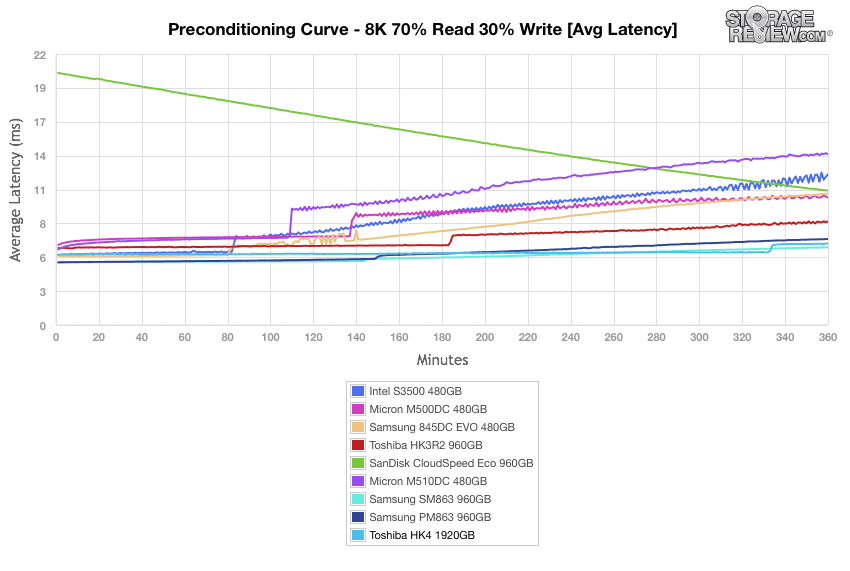
Max latency showed lots of jumps and peaks with all of the drives including the HK4. The HK4 was able to place third in the benchmark with max latency jumping between about 55ms and 40ms up until the end of the test.
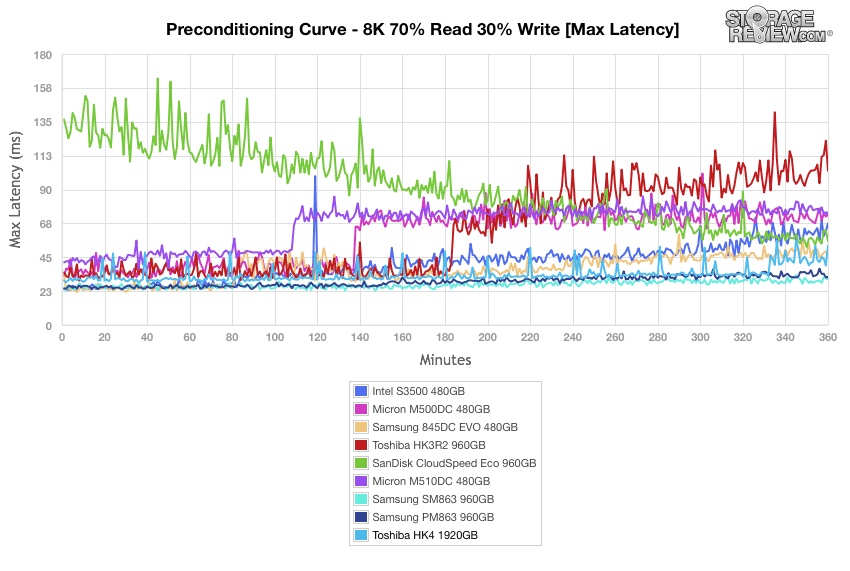
With Standard Deviation, the HK4 gave a more consistent performance, finishing second with a latency just under 5ms.
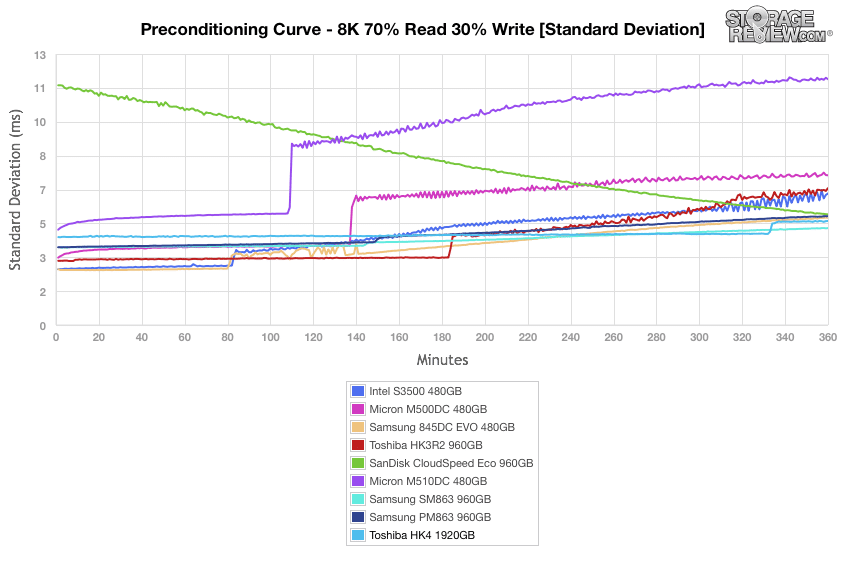
Once the drives are preconditioned, we switch over to our 8k 70/30 main benchmark. Looking at throughput, the HK4 came in second place peaking at 38,481 IOPS.
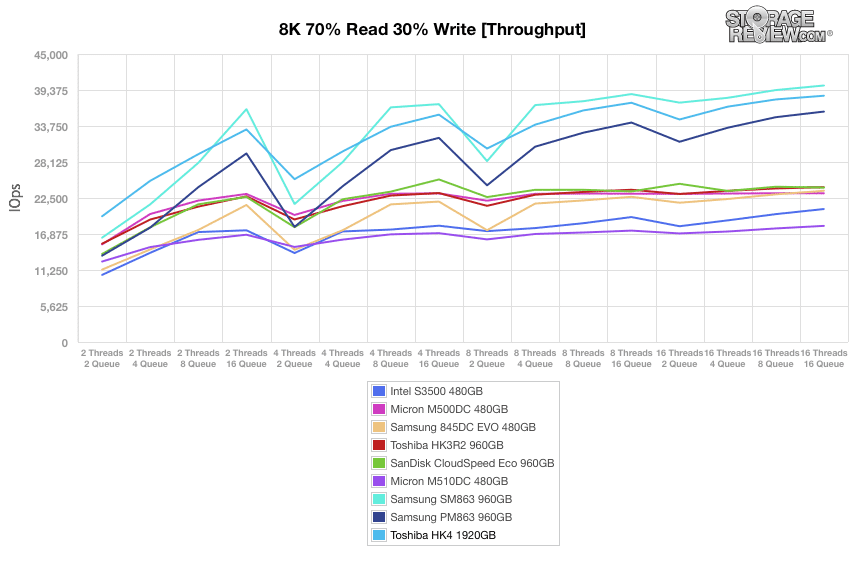
Average latency again showed a strong performance by the HK4, once again coming in second and finishing the test at 6.65ms, right behind the top performer’s 6.38ms, the Samsung SM863.
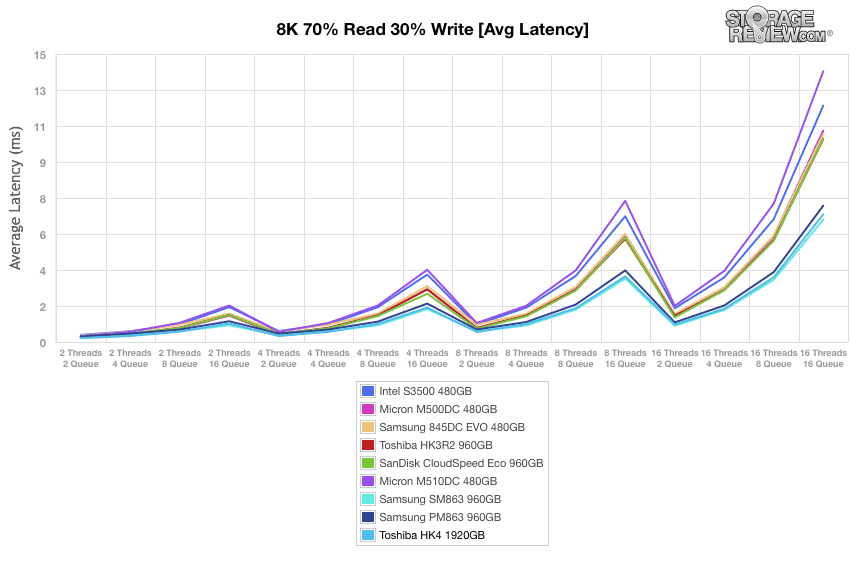
Looking at max latency the HK4 fell from its perch and landed in the middle of the pack. Here we saw the HK4 give us a max latency of 63.83ms, half of the worst performer (HK3R2 with 132.32ms) but nearly twice the latency of the best performer (SM863 with 34.32ms).
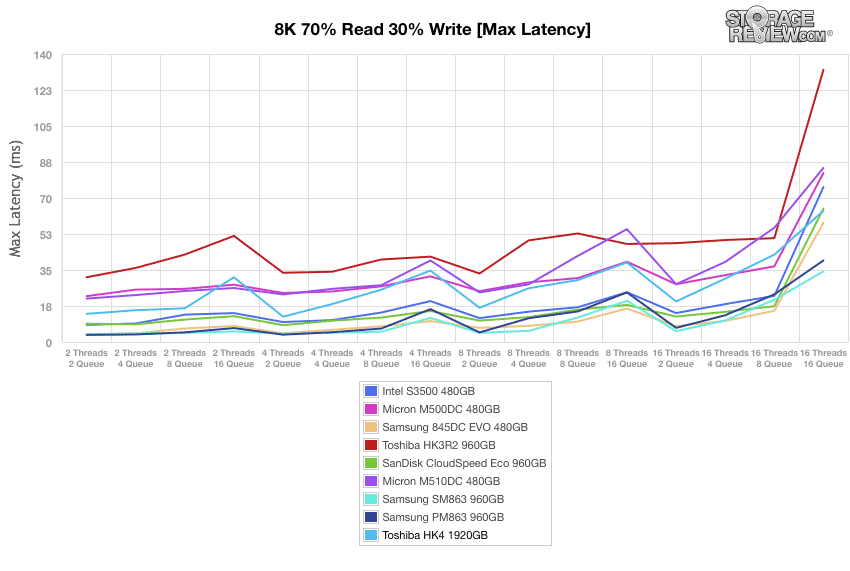
Standard deviation had a real neck-and-neck scenario at the end, but the HK4 was able to pull off a second place finish with a latency of 5.02ms.
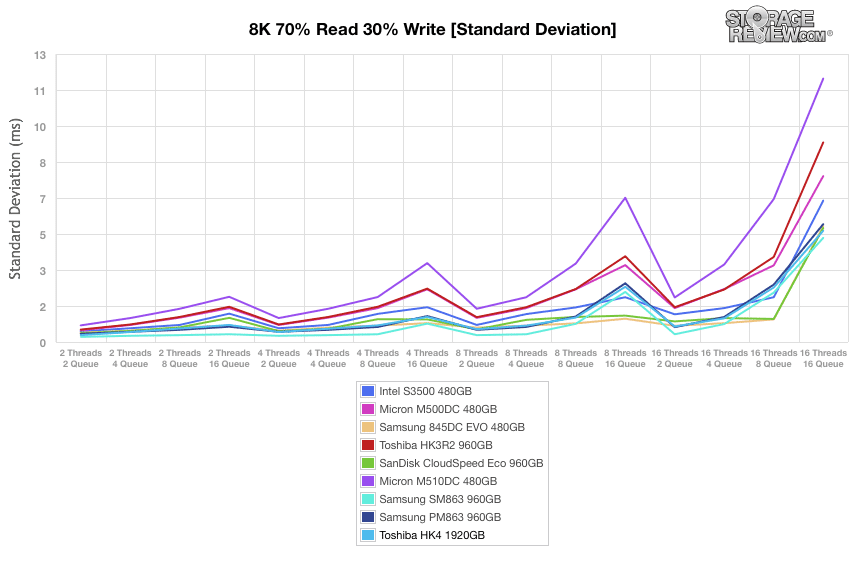
Conclusion
The Toshiba HK4 is a 2.5” enterprise SATA SSD that comes in two models: a read-intensive model (HK4R) and a high-endurance model (HK4E). The drives have capacity that ranges from 120GB to 1.92TB (depending on model type) and utilize Toshiba’s next-gen 15nm NAND as well as Toshiba controllers. This would make it one of the first SATA drives to hit the 2TB capacity point. The drives come with a 5-year warranty and are designed for a variety of use-cases including mixed workloads, web servers, files servers, media streaming, video-on-demand, search engines and warm data storage.
In our application workloads, we saw the Toshiba HK4R hold up well against the SAS3 comparables, although it was outclassed in the end by the much more expensive models. This was expected, but also shows how far Toshiba has been able to bring a SATA enterprise SSD in comparison to the SAS models. It gave us an aggregate score of 6,245 TPS with each VM having a performance of 3,122 TPS each in our SQL Server benchmark. The HK4 had a latency of 61ms (both individual and on average) in our SQL Server. In our Sysbench test running 4 heavily loaded MySQL VMs, we measured an aggregate TPS of 1787, an average latency of 72ms, and a worst-case scenario latency of 137ms.
Our synthetic benchmarks were more aligned with an apples-to-apples test (with the exception of the SM863 which is a mixed-use drive) with several SATA drives compared to the HK4. Here the HK4 shines a bit brighter moving up to the upper end of several tests. In our 4k benchmark, the HK4 placed second in write throughput with 30,688 IOPS and third in read throughput with 79,709 IOPS. The HK4 had the best write latency of the group with 8.34ms. In our 8k 70/30 benchmark the HK4 gave a strong performance on throughput, once again finishing second with 38,481 IOPS. The HK4 also gave us latency speeds of 6.65ms average, 63ms max, and 5.02ms standard deviation.
Pros
- Twice the capacity of the previous model
- Held its own against SAS3 drives in our application tests
- Above average performance in 4k throughput and latency
The Bottom Line
The Toshiba HK4R is a 2.5” SATA SSD that comes in capacities up to 2TB. The drive provides more than enough performance for read-intensive applications it is designed for, with a favorable economic profile compared to SAS offerings.




 Amazon
Amazon